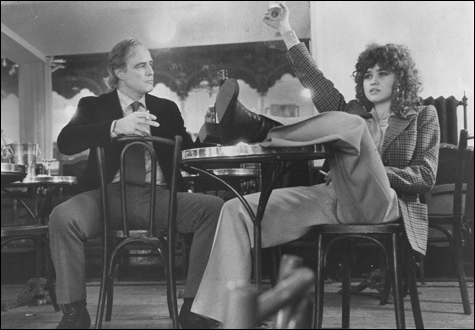
TWO FINGERS UP: How did Last Tango in Paris ever get taken seriously?
|
The omission from Indie Sex, the IFC’s new four-part history of sexuality in the movies, of an episode called “Wanks” is a surprising one: surely no survey of this field can call itself complete that fails to catalogue at least a few of cinema’s most venerably encrusted jerk-off sequences. On four consecutive midnights (August 1–4) we get “Censored,” “Taboos,” “Teens,” and “Extremes,” all very thorough and interesting, but no “Wanks.” Of the assembled talking heads, only recording artist Ari Gold (not to be confused with Jeremy Piven’s character on Entourage) seems to have the right idea: as a throbbing teen (he confides) he abused himself so ardently to the sex scene from The Terminator that the videotape was almost destroyed. In this spirit, would it be giving you too much information to tell you that a tape of Volker Schlondorff’s Swann In Love became, for a humid moment in 1985, the very text of my young libido? Quite possibly, because nobody mentions this film on Indie Sex. They do however mention Porky’s, another (perhaps more typical) event in my private sexual revolution. What a crappy film it was, and yet how imperishable is that scene where the gurgling high school boys leer through a tiny hole at a group of showering girls. Voyeurism in excelsis: the peephole is roughly at knee-level, and the strong-legged laughing girls, shaking water from their hair in the pride of their nudity, seem magnified and worshipped by this stolen gaze. Memories, steaming memories.
The four hour-long episodes of Indie Sex come at their subject from a variety of angles. “Censored” describes the complex dance performed by filmmakers around the various strictures and standards of officialized morality, including the Golden Age of triple-X porn and Deep Throat. But limits, as everybody knows, are a wonderful thing: with the enforcement of the Hays Code beginning in the ’30s, and with the ever-present threat of a boycott by the Catholic Legion of Decency, directors funneled the erotic yearnings of a mass audience into a highly refined symbolism. A woman accepting a cigarette from a man was at least thinking about giving him a blowjob; a woman slapping a man was flinging wide the doors to sexual Xanadu. Alfred Hitchcock, mindful of the Hays Code stipulation that no onscreen kiss should last for more than three seconds, created those fantastically intimate and prolonged sequences where Ingrid Bergman nuzzles Cary Grant (Notorious, 1946), or Grace Kelly nuzzles James Stewart (Rear Window, 1954), and the dialogue is breaths and murmurs and chaste little pecks to the mouth: hand in hand with the censor, in other words, Hitchcock more or less invented for the movies the smothering eroticism of physical proximity. Plenty was also lost, of course, beneath the cloak of censorship: Indie Sex gives us a beautiful submarine minute from 1934’s Tarzan and His Mate, excised from the original version, in which Tarzan (Johnny Weissmuller) and Jane (Maureen O’Sullivan) wheel in slow, blissful circles beneath the water of a jungle pool. Their movements are liquid sculpture: it took the lewd mind of a Hays Code enforcer to find indecency in the fact that O’ Sullivan happened to be naked.
The second episode of Indie Sex — “Taboos” — obliged me to reevaluate the work of director Todd Solondz. When Happiness came out in 1998 I found it to be a nearly inhuman exercise in stereotyped sexual humiliation — the blandly calculating pedophile, the phone pest with disgust coming out of his pores, etc. But viewed as part of a continuum that includes the giggling trash-explosion of John Waters’ Pink Flamingos (1972) and the bathos of David O. Russell’s Spanking the Monkey (1994), Happiness makes sense: with a grim clinical delicacy that is all his own, Solondz is probing the same areas. Repression, the unspeakable. . . . This would have been a great moment to interrogate, if only lightly, the current orthodoxy that the main business of the artist is to “push the envelope,” but Indie Sex doesn’t go there. The expert witnesses — Rosanna Arquette, Peter Sarsgaard, a gaggle of critics — are unanimous in their assent to ever-freakier sex scenes, trampling of taboos, and so on. Also running through the series is the touchingly democratic, quintessentially American idea that everybody has to be “represented” in the movies, that the dude who drinks maple syrup out of a wellington boot must see his reflection onscreen or else feel himself iniquitously disenfranchised. When these two tendencies meet, it seems to me, you get films like Todd Stephens’s Another Gay Movie (2006), whose hero is surprised with his dick in a quiche and a gerbil disappearing into his rectum. “I think I’m trying to say,” muses Stephens, interviewed by the makers of Indie Sex, “that, you know, sex is OKAY. Let’s just get over it and have some fun!” (Sound of libidos deflating across the universe.)
Can you stay up till midnight, you sexy beast? Four nights in a row? Give it a shot, because you’ll learn a lot from Indie Sex. You’ll learn that Catherine Breillat, boundary-busting French director of Fat Girl (2001), has an awesome funereal presence and a voice like a bear trapped in a wardrobe. You’ll gain a new respect for Fast Times At Ridgemont High (1982), after critic Jami Bernard points out the poetic verisimilitude of the scene where Jennifer Jason Leigh, losing her virginity, looks over the heaving shoulder of her swain and sees the words “SURF NAZIS” graffiti’d on the basement ceiling. And you’ll wonder how on earth Last Tango in Paris (1972) ever got taken seriously: the image of a ratty-haired Marlon Brando, half-god half-wino, demanding in his lockjawed way that Maria Schneider stick two fingers up his ass, now seems the reductio ad absurdum of improvised acting. In a related story, you’ll find out that the shower scene from Porky’s is not on YouTube. Bummer.